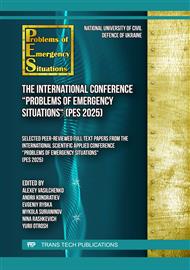p.17
p.27
p.37
p.53
p.67
p.81
p.89
p.101
p.109
Studying Fire Hazard of Premises of a Mobile Communications Base Station
Abstract:
The need to study the fire hazard of typical premises of a mobile communications base station was substantiated, in particular, regarding the feasibility of equipping it with an automatic (self-contained) fire-fighting system. Criteria for assessing the fire hazard of a mobile communications base station were developed. It was experimentally established that the greatest fire hazard in the premises of a mobile communications base station was related to the following devices: Alarm Box switching panel, input and distribution board, internal air conditioner unit and 12 V 100 A#2 batteries. Moreover, the latter two ones contribute to the spread of fire inside the premises. During the ignition of the 12 V 100 A#2 batteries, it was established that the surface of the outer wall further heated to a temperature of 80 °C, which did not exceed the critical one. Thus, the fire did not spread beyond the premises. It was established that equipping the premises of a mobile communications base station with a fire-fighting system in order to prevent the fire spreading beyond its boundaries was unreasonable.
Info:
Periodical:
Pages:
67-79
Citation:
Online since:
November 2025
Price:
Сopyright:
© 2025 Trans Tech Publications Ltd. All Rights Reserved
Share:
Citation:


